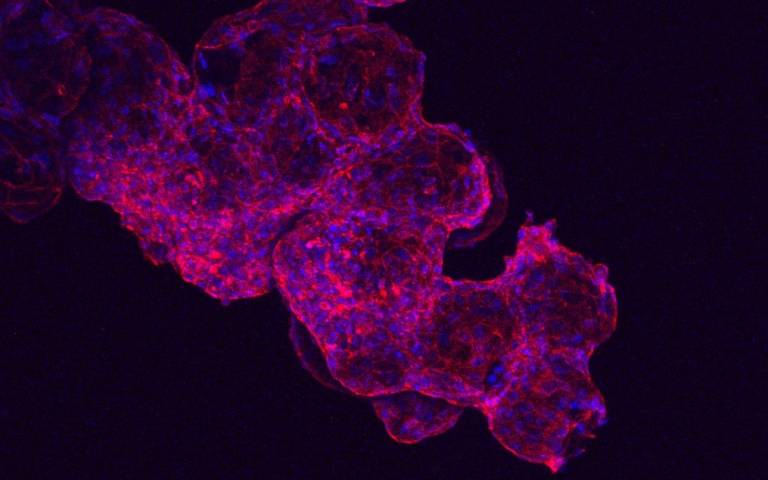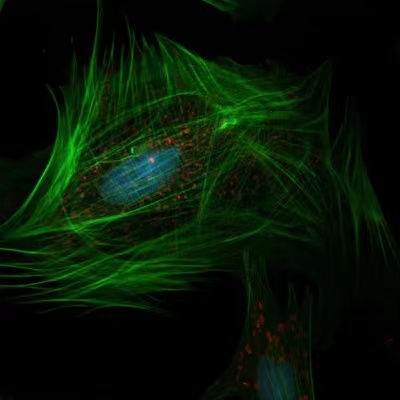创新背景
据估计,英国有92万人患有心力衰竭,随着心脏病发作后存活下来的人比以往任何时候都多,这一数字还在继续上升。多年来,科学家们一直试图使用干细胞修复受损的心脏。然而,这些细胞通常不能在心脏中保持健康状态足够长的时间来提供持续的益处。
创新过程
一个由英国心脏基金会(BHF)资助的伦敦大学学院的研究小组已经在微小的微球上培养出了人类干细胞衍生的心脏细胞,每个微球只有四分之一毫米宽,由生物材料制造。这些细胞附着在微球上生长,相互连接,并能在培养皿中跳动40天。微球的小尺寸意味着它们可以很容易地用针头注射到心脏肌肉中。

研究人员还进一步发展了最先进的技术以可视化注入的微球,并确认它们仍在原位。硫酸钡(BaSO4)可以在x射线和CT扫描中发光,它被添加到微球中并注射到大鼠心脏中。全身CT扫描证实,注射后微球在原地停留了6天。
研究人员表示,这项技术可以提供下一代材料,有效地向衰竭的心脏输送新细胞,以恢复其功能,并希望在未来10年进行人体临床试验。他们在英国心血管学会会议上展示了他们的发现。

伦敦大学学院高级生物医学成像中心心脏成像负责人丹尼尔·斯塔基博士说:“要真正修复受伤的心脏,干细胞的输送方式很重要,它能让干细胞在新环境中存活并转化为心肌细胞。”我们的技术提供了一种新方法,确保注入心脏的细胞正常工作。我们希望这项研究将给我们提供必要的信息,使干细胞治疗成为心脏病患者的现实治疗。
领导这项研究的博士研究生Annalisa Bettini(伦敦大学学院心血管科学研究所)说:“我们可以用这项技术做得更多——除了开发心脏注射,我们正在开发这些可追踪的微球,作为心脏补丁,可以简单地注射到心脏受损的特定区域。”心脏病发作后,心肌组织受损,自我修复能力有限,这增加了患者患心力衰竭的几率。英国心脏基金会医学副主任Metin Avkiran教授说:“这是一种很有前途的新输送系统,可以给干细胞来源的心脏细胞修复受损心脏的最佳机会。”
创新价值
在未来,这些技术可以为心脏病专家提供许多解决方案,为病人提供最好的治疗。
创新关键点
在微小的微球上培养出人类干细胞衍生的心脏细胞,每个微球只有四分之一毫米宽,由生物材料制造。这些细胞附着在微球上生长,相互连接,并能在培养皿中跳动40天。微球的小尺寸意味着它们可以很容易地用针头注射到心脏肌肉中。
创新主体
伦敦大学学院(University College London,简称:UCL ),1826年创立于英国伦敦,是一所公立研究型大学,为伦敦大学联盟的创校学院、罗素大学集团和欧洲研究型大学联盟创始成员,被誉为金三角名校和“G5超级精英大学”之一。
UCL是伦敦的第一所大学,以其多元的学科设置著称,于REF 2014 英国大学官方排名中,位列全英之冠,享有最多的科研经费。UCL的医学、解剖学和生理学、建筑学、教育学、考古学、计算机科学、计算金融学等学科排名均位居世界前列,与LSE并称为“英国现代经济学研究的双子星”;其人文学院颁发的奥威尔奖则是政治写作界的最高荣誉。
Innovative use of injected microspheres to repair failing hearts
A team at University College London, funded by the British Heart Foundation (BHF), has grown human stem cell-derived heart cells on tiny microspheres, each just a quarter of a millimetre wide, made from biomaterials. The cells grew attached to the spheres, connected to each other, and were able to beat in a petri dish for 40 days. The small size of the pellets means they can be easily injected into the heart muscle with a needle.
The researchers also further developed state-of-the-art techniques to visualize the injected pellets and confirm that they are still in place. Barium sulfate (BaSO4), which emits light in X-ray and CT scans, was added to the pellets and injected into rat hearts. A whole-body CT scan confirmed that the pellets remained in place for 6 days after injection.
The researchers say the technique could provide the next generation of materials that efficiently deliver new cells to a failing heart to restore its function, and hope to have human clinical trials in the next decade. They presented their findings at the British Cardiovascular Society conference.
Dr Daniel Starkey, head of cardiac imaging at UCL's Centre for Advanced Biomedical Imaging, said: "To really repair an injured heart, it is important to deliver stem cells in a way that allows them to survive in a new environment and turn into heart muscle cells. Our technique provides a new way to ensure that the cells injected into the heart work properly. We hope that this study will give us the information necessary to make stem cell therapy a realistic treatment for patients with heart disease.
PhD candidate Annalisa Bettini(UCL Institute of Cardiovascular Sciences), who led the research, said: "We can do so much more with this technology - in addition to developing cardiac injections, we are developing these traceable microspheres as cardiac patches that can be simply injected into specific areas of the heart that have been damaged." After a heart attack, the heart muscle tissue is damaged and has a limited ability to repair itself, which increases the chances of patients developing heart failure. Professor Metin Avkiran, associate medical director at the British Heart Foundation, said: "This is a promising new delivery system that could give stem cell-derived heart cells the best chance of repairing damaged hearts.
智能推荐
生物技术创新 | 利用生物光伏为小型设备供电
2022-06-30利用藻类的光合作用生成生物光伏进行不间断的光电转化提供电力。
涉及学科涉及领域研究方向使用“高速光片”显微镜可实时观察活组织细胞
2022-08-08使用高速3D显微镜MediSCAPE捕获活组织结构的图像,实时检测组织健康状况。
涉及学科涉及领域研究方向创新“活体3D生物打印”创造新组织
2022-08-04伦敦大学学院的一个研究小组利用一种名为“活体3D生物打印”的微创技术,成功地在小鼠身上制造出了新的肌肉。
涉及学科涉及领域研究方向创新研发“分子手术刀”清除细胞表面的无用蛋白质
2022-08-17斯坦福大学的化学家们开发了一种新的工具,可以将不需要的细胞表面蛋白质运送到它们死亡的地方。
涉及学科涉及领域研究方向